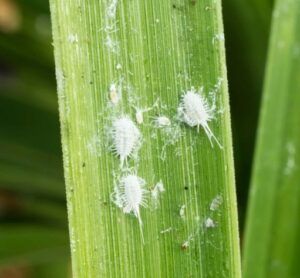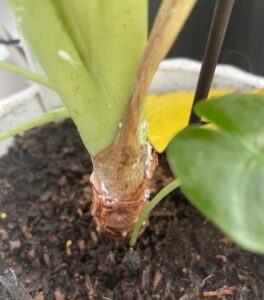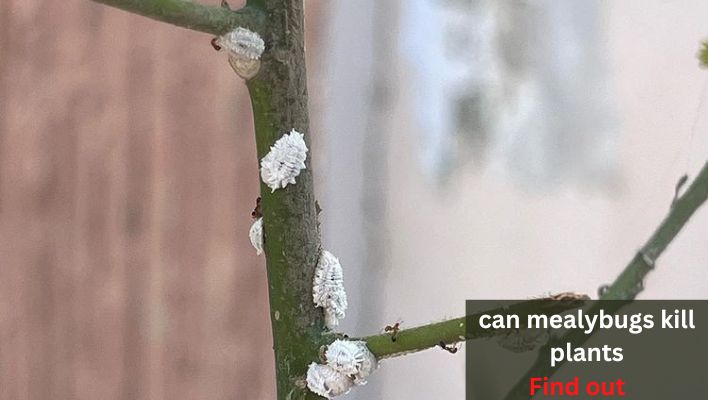I know that mealybugs are familiar in your gardening because they are common pests for plants. But can mealybugs kill plants?
Because it is not your first time seeing mealybugs on your plants, we assume you know what they are. However, what if you are wrong? And you have been mistaken for aphids for mealybugs because they both excrete honeydew.
Mealybugs are small, gnat-like, white pests that feed on sap and attach themselves to the underside of leaves and stems. They’re often confused with scale or aphids, which can be treated similarly, but mealybugs differ in appearance.
Mealybugs can cause them to become diseased and ultimately die if they are allowed to proliferate on their own.
There are many species, and they are considered pests. However, their occurrence can sometimes be beneficial and detrimental to your garden.
While there are many ways to control mealybugs, you should note that they are difficult to eliminate once they have infested your yard or garden.
What are mealybugs
Mealybugs are tiny, soft-bodied insects that live on plant leaves. They are related to aphids, whiteflies, and scale insects. Mealybugs tend to cluster together and lay their eggs in dense masses. The tiny larvae that hatch from these eggs are called crawlers.
Mealybugs generally are small, flat insects that feed on plant sap and can cause leaves to become distorted or even fall off completely. They thrive conveniently in a warm and moist environment. They are often found on the undersides of leaves, although they can also be found on the upper sides.

Mealybugs are also known to secrete honeydew, a sticky substance that attracts ants who then carry the mealybug’s eggs back to their nests, where they will eventually hatch. They are most commonly found in greenhouses, where they feed on plants such as tomatoes and peppers.
Mealybugs have been known to spread disease among plants by contaminating them with sticky excrement. They tend not to attack trees or other woody plants but prefer succulent growths such as weeds or ornamental shrubs.
Mealybugs can kill plants.
Mealybugs are a type of insect that feed on plant sap, causing the plant to wilt and die. Mostly they can be found on plants, especially indoor plants. And if they infest a tree or shrub, they’ll cause branches to die and leaves to drop off. In both cases, your plants will eventually die if you don’t treat them with an effective pesticide.
They are not harmful to humans, but they do cause damage to plants by sucking their sap and leaving behind a sticky residue. In fact, in some cases, they’re a useful part of the ecosystem because they eat aphids and other insect pests.
They have a gelatinous coating around their body, which makes them look like pale white grains of rice or flour. They’re often found in clusters on the underside of leaves or young stems or leaf undersides near the veins.
Mealybugs can spread disease through their droppings, so if you notice other diseases spreading in your garden while you’re fighting this one off (or vice versa), make sure you treat both problems at once.

The process by which mealybugs kill plants
Mealybugs are found in almost every type of plant and can be found on plants as young as seedlings to mature trees.
They live on the leaves of plants and feed on the sap found there. When mealybugs feed at night, they block out light for the plant’s photosynthesis processes, reducing its ability to grow. This feeding causes the leaves to become pale and stunted, eventually leading to the death of the plant.
Mealybugs also secrete a sticky substance called honeydew that collects on leaves and drips onto the soil surface below. This causes excess water to accumulate around plants and makes them more susceptible to diseases and other pests like ants.
Symptoms of a mealybug infestation
The most common symptom of mealybug infestation is an irregularly shaped, light brown patch on the underside of leaves. The brownish coloration is caused by their excrement, which sticks to the leaf surface and stains it yellow or black.
Other symptoms include small white dots or specks on plant leaves that look like powdery dandruff. Another symptom is when some leaves become discolored and wither away in patches near the edges of leaves or along stems where branches meet other branches.
This occurs when there is a lot of honeydew on leaves, causing them to turn yellow or brown with dead tissue.
You’ll also notice small bumps on your fruit or vegetable where mealybugs are developing their eggs. These bumps will look like tiny black dots on the surface of your food, and they’ll usually be located near where the vegetable was attached to something else before being picked up by you.
The mealybug infestation can cause damage to your plants, including:
- Damaged leaves with grayish-white spots that turn brown
- Leaves that curl up or wilt
- Leaf veins turning brown, especially on the edges of leaves
- Numerous mealybugs flying around your garden
- Plants become dull and lose vigor
What you should do if you have mealybugs
If you find mealybugs in your plants, treating them as soon as possible is important. An effective mealybug treatment is the best way to get rid of them.
Attack them with neem oil
If you have mealybugs, you’ll want to attack them with neem oil. Neem is an effective natural insecticide and safe for use around plants.
Neem oil has been used for centuries as a natural pest-control agent. It’s an effective way to kill mealybugs and other insects that infest your garden. Neem oil can also be used to treat the soil of your plants if you suspect pests are lurking.
Neem oil is a great home remedy for mealybugs because it contains a natural pesticide that kills insects. This can be applied to your plant’s leaves and stems or sprayed onto the mealybugs themselves.
You can get neem oil at your local garden center or online, which will help you kill off the pests causing you trouble.
Just mix neem oil with water in a spray bottle, spray the plant with this mixture, and let it sit for five minutes before wiping away any excess liquid. You’ll need to repeat this process three times over two days to ensure they’re gone.
Use Diatomaceous earth (DE).
Diatomaceous earth is a naturally occurring substance that kills insects and other pests. It’s commonly used for gardens but can also be used on plants to control insect pests. Check here for a detailed guide on how to use DE.
You can sprinkle DE around infested areas on your indoor plants or mix it with water and spray the solution directly onto the plant leaves. Remember that some plants may need extra care during this process, so check with your local nursery before using DE.
DE is also thought to be beneficial for preventing other insect infestations by killing off their food supply and preventing beetles from laying eggs on plants.
Use Eucalyptus oil.
It’s an all-natural alternative that will kill the mealybugs on contact. You can apply it directly to the plant or spray it on the leaves as a preventative measure.
If you have mealybugs, you should use eucalyptus oil to kill them. You can buy it at the store or make your own. Eucalyptus oil is a natural repellent that will drive away mealybugs and other insects.
To use eucalyptus oil:
- Mix 5 drops with 2 cups of water in a spray bottle.
- Spray this mixture on all surfaces where mealybugs are found.
- Rinse or wipe down any surfaces sprayed with the solution with a clean cloth or paper towel.
- Repeat this process as needed until there aren’t any more signs of mealybugs in your house or garden.
Eliminate mealybugs with soap water.
Soap is an effective treatment for mealybugs because it kills insects and their eggs. However, you should use a mild soap that does not contain harsh ingredients such as bleach or ammonia.
Using a spray bottle, mist the infested area with the liquid solution and leave it on until you see signs of death, usually 2-3 days.
Treat mealybugs with alcohol. Alcohol and water
Alcohol kills mealybugs and eggs by dissolving their waxy coating. It’s also a very effective treatment for scale insects, which are common in homes.
A homemade spray made of 1 tsp rubbing alcohol and 1 cup of water will help to eliminate this bug from your garden. Mix the alcohol and water in a spray bottle to make this spray.
Spray this solution onto the plant leaves where you suspect the mealybugs are hiding. You should repeat this process once every day for about two weeks until all signs of the mealybug infestation have been eliminated from your garden.
Use horticultural oils
The oils are a safe and effective way to eliminate these insects. They can be applied to the base of your plants and then watered into the soil. Or they can be sprayed directly onto the mealybugs themselves.
You should also ensure you keep your plants fresh; these oils work by suffocating the bugs inside their cocoons. They can be purchased at any gardening store.
In order to use horticultural oils, you will need to spray them on the affected area of your garden or landscape. You can also use horticultural oils and other treatments like pesticides or fungicides.
To treat the entire plant, mix 1 tablespoon of horticultural oil with 2 cups of water in a sprayer and mist over the plant until it is evenly coated.
Use vinegar
Vinegar is a great way to get rid of mealybugs. You can use it in your garden or on the plants you want to protect from mealybugs, and it’s easy to do.
What you’ll need: 1 part white vinegar (about 5 tablespoons) per 1-quart spray bottle
How to use: Spray diluted vinegar onto the leaves or stems of the plant or part with mealybugs. Let it soak in for a few minutes before rinsing or wiping it off with a cloth or paper towel. You can dip the affected area in a mixture of water and vinegar, then rinse with clean water.
Best insecticide for mealybugs
You can opt for proven insecticides and pesticides to get rid of mealybugs from your plants and keep them healthy for a long. This will save you the stress of trying different methods. Below are some of the best pesticides for mealybugs to use; they are safe for pests and children.
Grower’s Ally Crop Defender 3
Grower’s Ally Crop Defender 3 Insect Control for Mealybugs is a plant-based insecticide that works by disrupting the mealybug’s metabolism. You can use it on your indoor plants or outdoors in your garden.
This insecticide can be used on various plants in your garden. It will not harm any of your beneficial insects, so you don’t need to worry about any other bugs in your home or yard getting hurt.
This product was designed to allow growers to treat their crops without damaging them or spending much money on chemicals. It is also safe to use around pets and children, so you don’t have to worry about accidentally poisoning your family while trying to get rid of those pesky mealybugs.
Grandevo CG Bioinsecticide
Grandevo CG Bioinsecticide is an effective way to control mealybugs. It works by attacking the pests’ reproductive systems and killing them. The product is safe for humans, pets, and plants.
Grandevo is an organic formulation that kills on contact, has no harmful side effects, and is easy to apply. It contains a natural insecticidal compound called neem oil, which interferes with the insects’ nervous system. This makes it easier for them to die from exposure or infection.
As a bonus, it also helps control other types of pests like aphids, mites, and thrips, so you can use it in tandem with our other treatments to eliminate them.
Safer Insect Killing Soap Concentrate
Safer Insect Killing Soap Concentrate is a soap solution that kills and repels mealybugs. It is used to treat mealybugs on indoor and outdoor plants.
Safer Insect Killing Soap Concentrate is safe for humans and pets but should not be applied directly on the skin or ingested.
This product can also treat aphids on fruits, vegetables, and ornamentals. Safer 5118-6 Insect Killing Soap Concentrate can also treat other pests such as spider mites, scale insects, gnats, whiteflies, and aphids.
Monterey Spinosad insecticide spray Garden
The Monterey Garden Insect Ready to Spray Insecticide contains two active ingredients: spinosad and imidacloprid.
Spinosad is a naturally occurring neem seed extract that kills pests by interfering with their nervous system. This insecticide is often used in treating ants, termites, chinch bugs, fleas, cockroaches, and other insect pests.
Imidacloprid controls a wide range of insect pests, including aphids, beetles, flies, flies larvae, leafhoppers, and thrips on vegetables; leafminers on fruit trees; scales on citrus fruits; mealybugs on ornamentals; leaf miners on foliage plants; thrips on indoor plants; whiteflies on flowers; whiteflies on vegetables; bud moths on roses; scale insects on ornamentals (e.g., azaleas); thrips and whiteflies on indoor plants (e.g., ficus); mites.





